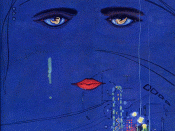The story of The Great Gatsby takes place over one summer in 1922 in Long Island. On the surface it is a love story with a tragic ending but if one looks deeper into the novel's symbols and themes, one finds that it deals with larger, more serious social and existential issues. The Great Gatsby is a symbolic criticism of 1920s America and the corruption of the American dream by material excess and moral decay.
Fitzgerald portrays this decline by the fate and interactions of various characters typical of that place and era. Gatsby lives in a huge mansion on the "West Egg" of Long Island, paid by the proceeds of bootlegging and other crimes. His friend Nick lives next door in a more modest house. They were both soldiers in World War I. The people living on the West Egg represent the new money, much of it earned by dubious means.
On the other side of the bay in an area called East Egg the inhabitants are the old American money aristocracy.
The huge parties and wild jazz music which became fashionable in the 1920s are epitomized in The Great Gatsby by the lavish parties that he throws every Saturday night. The reader sees these parties as symbolic of the flaunting of material wealth and the unrelenting pursuit of pleasure. The various social climbers who attend Gatsby's parties are nameless freeloaders who just drop in to enjoy the free food and drinks. This demonstrates to the reader how this society has become disengaged from the traditional American values and aspirations.
Fitzgerald saw the American dream as one of discovery, individualism, and the pursuit of happiness. In the roaring twenties he depicts in the novel, however, easy money and declining social values have corrupted this dream, especially on the East...


